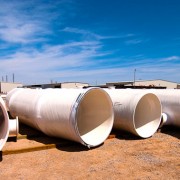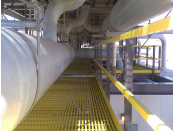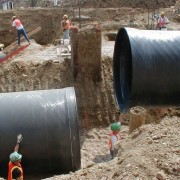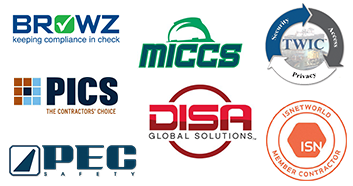Corrosion Resistance: FRP for Copper Recovery Systems
 There are many advantages to using Fiber Reinforced Polymers (FRP); high strength-to-weight ratio, dimensional stability, long service life, and reduced maintenance cost—to name a few. FRP can also be formulated with enhanced properties such as corrosion and abrasion resistance and smoke and flame retardance. In many stringent industrial applications, including copper recovery, where other materials fall short FRP has the ability to endure, thrive, and perform.
There are many advantages to using Fiber Reinforced Polymers (FRP); high strength-to-weight ratio, dimensional stability, long service life, and reduced maintenance cost—to name a few. FRP can also be formulated with enhanced properties such as corrosion and abrasion resistance and smoke and flame retardance. In many stringent industrial applications, including copper recovery, where other materials fall short FRP has the ability to endure, thrive, and perform.
FRP is commonly used as a cost-effective material solution because it can be formulated to withstand strong acids, bases, and organic compounds. Moreover, FRP is recognized as having superior corrosion resistance, when compared to specialty alloy metals, in aggressive hydrometallurgical and chemical process environments.
Copper Recovery
The copper recovery process is dynamic and has been simplified over time with the development of chemical processes and other technological advances. In copper recovery systems many of the chemicals/compounds that are used are hazardous and highly corrosive. For this reason, careful planning and thought must go into what building materials are selected for facilities. FRP has evolved in concert with the ever-changing metal and extraction industry and is now poised to fill many material niches.
In the copper recovery industry FRP is currently filling a niche as a cost-effective, corrosion resistant material, which can be utilized for many processes and applications including:
- Leaching
- Stripping
- Solvent extraction
- Sulfuric acid
- Copper sulfate electrolytes
In the copper recovery process copper is leached from ore with sulphuric acid and is easily recovered in a pure metallic form by the well known process of solvent extraction. At the center of the process is the copper recovery reagent that is used to selectively extract copper from the aqueous leach solution. In general terms, the copper recovery process can be broken down into three basic steps: leaching (sulfuric acid), solvent extraction, and stripping (high acidity coppers sulfate electrolytes). Beyond these three steps, the process of copper recovery has many areas where FRP products can be used; for example, transportation, storage, and general infrastructure needs.
FRP
FRP offers design flexibility; in metal extraction and refining industries it can be used for pipes, ductwork, tanks, solvent extraction vessels absorption towers, basins, floor coverings, grating, and electrowinning tankhouses— just to name a few. Case in point, FRP grating has been successfully used as a walkway/platform material in copper recovery systems around vats in the electrowinning process.
Whether you’re handling corrosive compounds such as sulfuric acid or high acidity extractants and stripping agents, FRP will withstand the harshest environments and is a corrosion resistant, cost-effective choice. In the metal and extractions industry FRP has a distinct advantage over metal alloys, including titanium, and rubber-lined steel with lower installation costs, reduced maintenance, and long service life proven with over 20 yrs of successful operating experience at many plants/facilities around the world.













